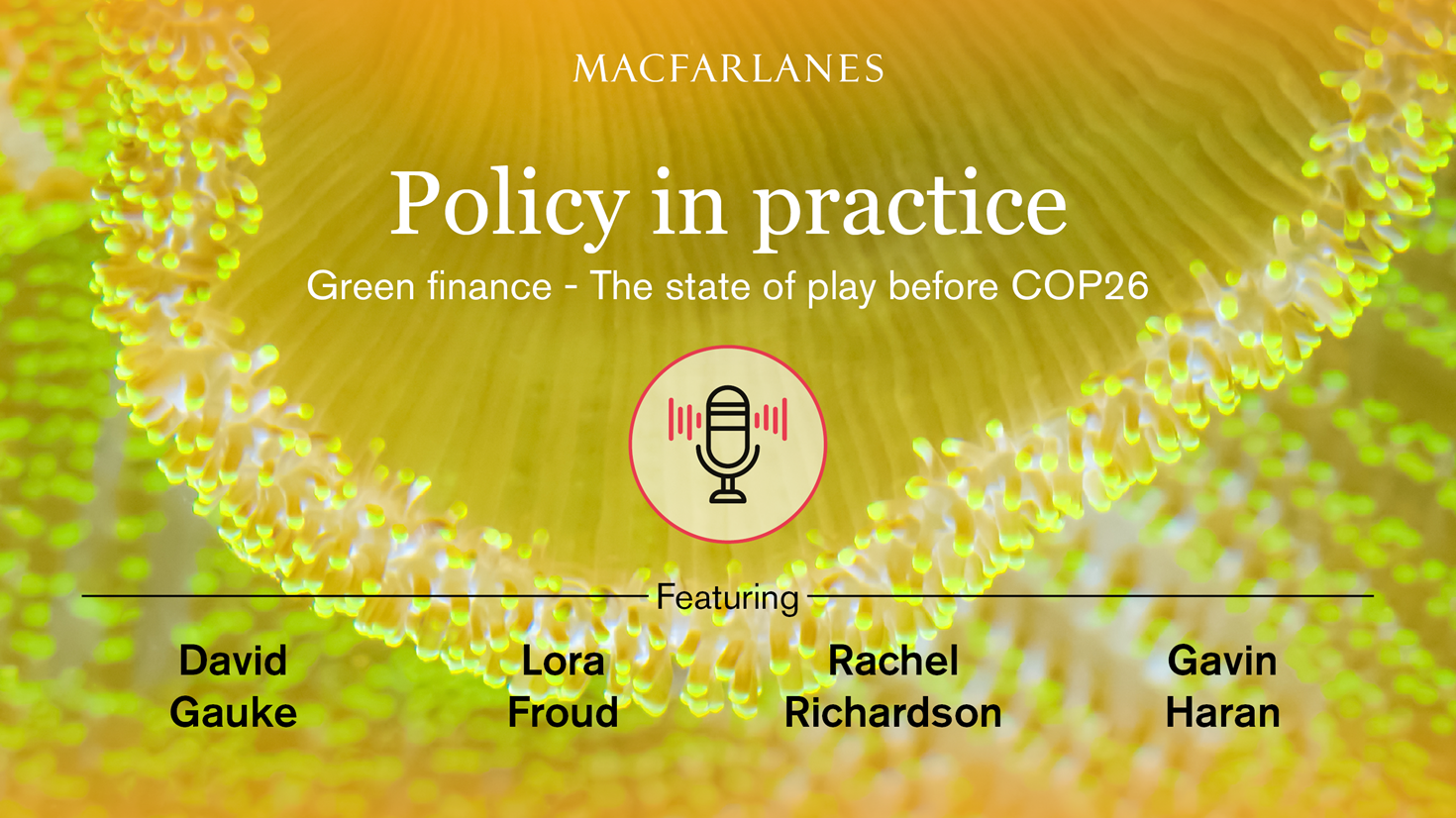The Chancellor unveils his plans for the UK’s version of SFDR
21 October 2021The UK Government has published the details of its long-awaited framework to “kick-start a green industrial revolution”, ahead of the country hosting the UN’s climate conference, COP26, in November 2021.
The Green Finance Roadmap (the "Roadmap") outlines the UK’s proposed approach to go beyond leading global standards in order to support the UK’s ability to withstand climate related risks and transition to net zero, by shifting investment into sustainable projects and green technology.
The Government’s view is that the financial system is critical to achieving net zero and protecting the UK’s natural environment. The Roadmap is almost exclusively focussed on climate change and other environmental issues and there is little mentioned at this stage of driving change in social and governance matters.
The key components of the Roadmap are as follows:
1. Aims
The Government considers there are three phases to “greening the financial system”: (i) improving the flow of information on environmental sustainability from companies and financial market participants to investors and consumers so they can make more informed choices; (ii) ensuring that sustainability information is integrated into businesses and financial decisions, for example in risk management and investor stewardship; and (iii) shifting financial flows to green projects to align with the UK’s net zero carbon commitment and broader environmental goals.
Policymakers envisage that the Roadmap will help to tackle "greenwashing" in which businesses make misleading or unsubstantiated environmental claims about their products or services.
2. Sustainability Disclosure Requirements (SDR)
What is the SDR: The SDR is the UK’s sustainability disclosure framework designed to ensure that sustainability information flows into the real economy in order to empower investors and consumers to make financial decisions which align with their values.
What are the requirements: It will require those in scope to disclose information around governance, strategy, risk management and performance against metrics and targets in the context of sustainability related risk. The idea is that the same types of disclosures are required by those in scope in order to ensure consistency in the metrics that are reported through the chain of investment to end investors.
In particular, the SDR framework will require disclosures on transition plans to net zero, and incorporate the UK’s economy-wide roll-out of mandatory reporting in line with the Taskforce on Climate-related Financial Disclosures (TCFD) and the International Financial Reporting Standards (IFRS) Foundation’s work on a global company ESG reporting standard (under a new International Sustainability Standards Board).
Who is in scope: UK registered corporates and certain UK listed issuers, UK asset managers and asset owners such as pension schemes and insurers, and investment products are all in scope.
Timing: A discussion paper on SDR disclosures will be launched in November 2021 and the requirements are unlikely to be in place for at least a further two years.
Those in scope of TCFD reporting may need to implement TCFD reporting before SDR becomes applicable in accordance with the economy-wide roll-out from this year through to 2025.
3. Sustainable investment labelling regime
What is the sustainable investment labelling regime: All UK investment products must be labelled objectively in accordance with specified sustainability criteria (taking into account products’ objectives, policies, strategies and asset allocation).
Who is in scope: UK investment products.
Timing: The FCA intends to publish further detail in an Autumn 2021 discussion paper and is establishing an advisory forum to help inform the work. The requirements are unlikely to become effective for at least a further two years.
4. UK Green Taxonomy
What is the UK Green Taxonomy: The UK Green Taxonomy will define the criteria which specific economic activities must achieve to be deemed environmentally sustainable and therefore "Taxonomy-aligned".
What are the requirements: Those in scope will be required to disclose the proportion of their activities which are Taxonomy-aligned, and providers of investment funds and products will have to do the same for the assets in which they invest.
The UK Green Taxonomy will adopt the same six environmental objectives that comprise the EU’s version, each underpinned by technical screening criteria (TSC), and the principle of "do no significant harm" to the other objectives. The six objectives comprise climate change adaptation, climate change mitigation, water use and marine resources, circular economy, pollution, and biodiversity. Like the EU’s Taxonomy, the UK’s version also recognises activities which are working to meet environmental objectives in the future, for example by enabling contributions to environmental objectives, but which are not yet sustainable themselves e.g. manufacturing components for wind turbines.
Who is in scope: As for SDR.
Timings: The Government expects to consult on the draft TSC for the first two objectives of the UK Green Taxonomy (climate change mitigation and climate change adaptation) in Q1 2022. It aims to pass legislation by the end of 2022. Consultations on the TSC for the remaining four objectives (sustainable use and protection of water and marine resources, transition to a circular economy, pollution prevention and control, and protection and restoration of biodiversity and ecosystems) are likely in Q1 2023, before legislation is put to Parliament.
The Government intends to review the Green Taxonomy every three years. After the UK’s primary legislation receives Royal Asset, the Government will require the most "economically significant" UK-registered and UK-listed companies to incorporate ISSB and Green Taxonomy disclosures in their company annual reports within one to two years. Subject to consultation, other in scope entities (asset managers and asset owners, investment products and financial advisers) will be required to similarly report after two to three years.
5. Investor stewardship
What are the requirements: Those in scope will be required to use the information generated by SDR to integrate ESG considerations into their investment decision-making, their shareholder engagement, their escalation and collaboration practices, and in their voting practices.
Practically, this means that firms are expected to apply standards such as the UK Stewardship Code 2020, to make use of information provided by the SDR, to be activist in their investee company engagement, to be transparent about their stewardship, and to have developed net zero transition plans. Financial advisers will also be required to consider their client’s sustainability preferences.
Who is in scope: UK asset managers and asset owners.
Timing: The work on stewardship is more piecemeal, comprising existing standards and regulatory work underway, in addition to the series of expectations set by the Government. The Government intends to assess progress against its expectations at the end of 2023.
6. International engagement
The UK Government intends to act on a global level through its membership of organisations such as the International Platform on Sustainable Finance, and the Network for Greening the Financial System. The FCA is also working closely with the IFRS Foundation (which resides in London) on the creation of a global company ESG reporting framework, which will be incorporated into the SDR. The Roadmap also details the UK’s green finance-related priorities for COP26.
7. Other aspects
- UK regulators will consider the role of ESG data and ratings providers and the Government will set out further detail next year.
- The Government and regulators are considering how to deliver an approach to digitisation of sustainability data which includes assessing the value of a centralised register for ESG data.
Initial reaction
The Government should be commended for proposing a framework that is comprehensive in its scope, and therefore that might succeed in achieving its policy aims.
The UK appears to have learned from the EU’s experience by seeking to implement its reforms across the economy, helping to resolve issues around data gaps and data quality that can arise if parts of the investment chain are subject to ESG regulations at different times. It is also clear that the UK wishes to draw on the EU’s successes, not least in its Green Taxonomy.
There remains a lack of detail in many areas that should be resolved by consultation. Whether proposals such as company ESG reporting and a green product label are helpful or too onerous, useful, or too complex, is yet to be seen. The scope of captured entities is also not clear; namely, which companies and which types of funds will be required to report.
It is helpful that the Government wishes to ensure that its rules are consistent with comparable international standards. Although, as expected, it seems the UK’s SDR framework will not be the same as the EU’s SFDR framework, which will cause compliance headaches for those operating in both jurisdictions.
However, it will be a challenge for the Government to strike a balance between its policy aims and its dependence on other countries’ or organisations’ standards. A lot will depend on the degree to which the UK can lead or influence international agreements.
Listen to episode 1 of our policy in practice podcast where our team of experts discuss green finance.

Get in touch


